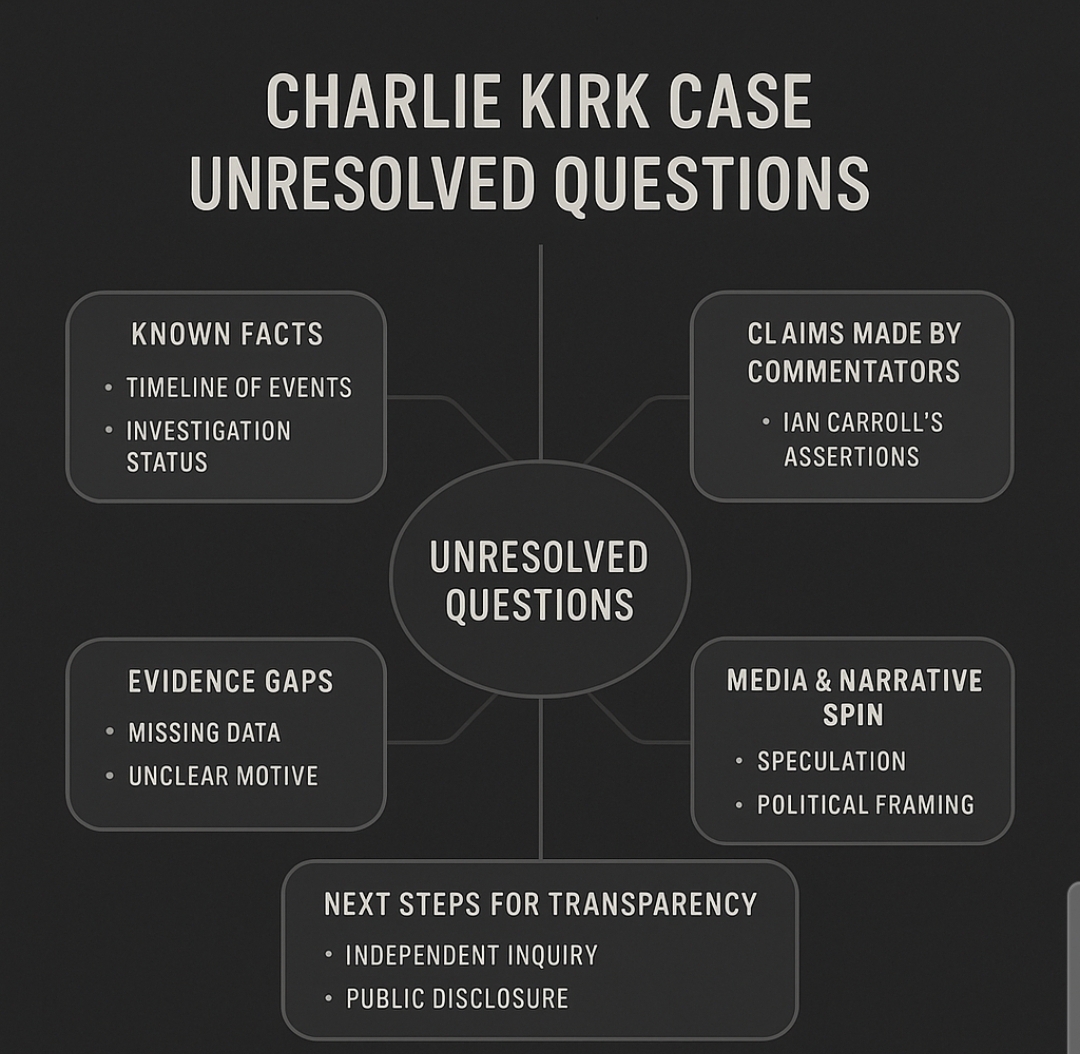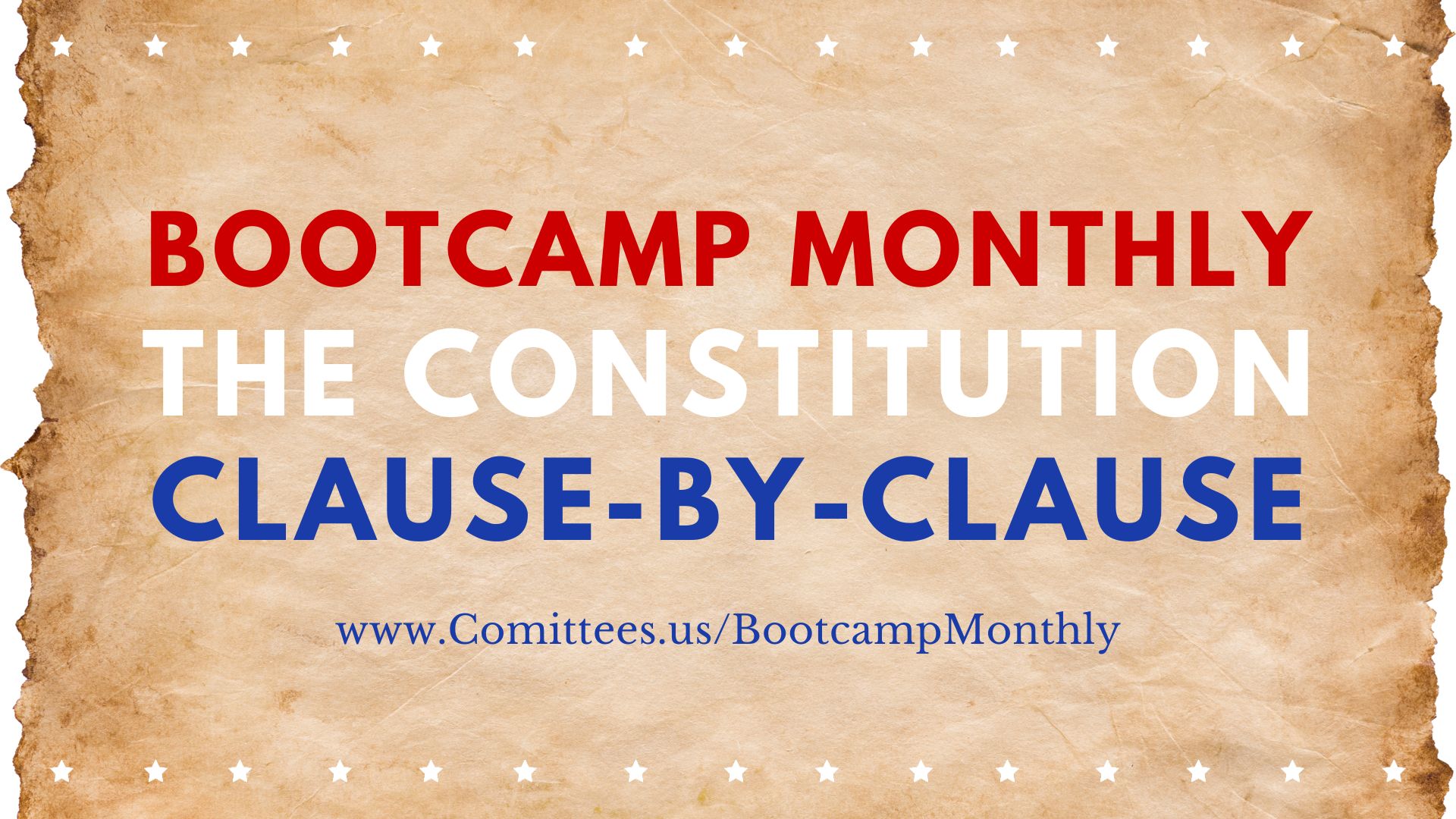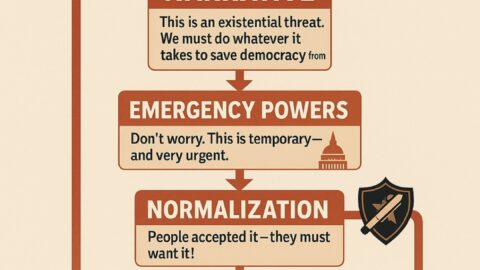The Core Claim
Carroll’s thesis (in his own framing): there is “more than enough evidence to ask” whether intelligence services—including Israel’s—played some role in Charlie Kirk’s assassination. He stresses an investigatory posture, not a verdict: keep Israel on the suspect board until the evidence record is complete.
Keeping Israel on the board
1) Timeline and evidence anomalies
- Shifting official details: He highlights early inconsistencies he says appeared in reporting and briefings (e.g., whether the rifle was assembled/disassembled; clothing descriptions; minute-by-minute movement on stairwell/roof).
- Forensics gaps: He points to disputes over an exit wound vs. a bullet found “beneath the skin,” and asks whether chain-of-custody and ballistics link the recovered round (if recovered) to the alleged weapon.
- Withheld materials: He flags missing or unreleased items—full autopsy, complete CCTV/stairwell footage, high-resolution rooftop imagery, and unredacted comms logs—arguing that partial disclosures invite speculation.
- The “decoy” arrest: He treats the George Zinn episode (statements oscillating between I did it and I helped the real shooter) as unresolved oddity that demands context, not as proof of anything.
Why this matters in his story: unexplained shifts or redactions create informational vacuums that can hide incompetence—or design. Either way, he says, they justify rigorous scrutiny of all hypotheses.
2) Donor pressure as motive-space
- Documented blowback: He cites on-air comments and reported texts about donor anger when Kirk platformed Tucker Carlson and Dave Smith, and when he questioned hawkish moves toward Iran.
- Netanyahu friction: Carroll repeats claims that Kirk was frustrated with Netanyahu’s political hardball and with attempts (through allied donors) to police who Kirk could host.
- The movement split: He frames Kirk as caught between a youth base drifting toward restraint and a donor class aligned with traditional Israel-first priorities.
Why this matters: If powerful benefactors tried to steer Kirk’s speech—and if he resisted—Carroll says that builds a plausible motive-space for pressure campaigns. He does not claim this equals a kill order; he argues it means investigators shouldn’t exclude politically connected actors a priori.
3) Capability & precedent
- Competence to act abroad: He notes Israel’s long-reported record of covert, extraterritorial operations (assassinations, sabotage, renditions) to argue capacity and tradecraft exist.
- Intelligence cutouts: Echoing his broader thesis, he says modern services use intermediaries (criminal, paramilitary, private) for plausible deniability—so “direct fingerprints” are rare by design.
Why this matters: Capability plus deniability is not proof of involvement; it’s his rationale for not taking any capable service (Israel’s included) off the list prematurely.
Competing hypotheses he keeps in play
- Lone-actor / non-state scenario: The official narrative could be broadly correct; anomalies might stem from chaos, media error, or prosecutorial caution.
- Domestic intel or other state actors: Given U.S. political stakes, he says American services—or third countries with equities—also belong on the board.
- Hybrid scenarios: Outsourced operations, parallel efforts, or opportunistic exploitation after the fact.
Disclosures and tests he says would clarify the picture
- Complete, timestamped video: Stairwell, rooftop, ingress/egress, and the “back-camera” footage.
- Forensic transparency: Autopsy (with family consent), wound path analysis, ballistics linking bullet → barrel, full chain-of-custody.
- Digital evidence: Authenticity checks on texts/notes; device logs; clear accounting of any “digitally reconstructed” documents.
- Aviation/comms records: ATC/FAA logs and interviews to reconcile any flight-data disputes cited in the discourse.
- Donor/pressure paper trail: Emails, texts, and internal memos showing whether political pressure crossed into coercion.
What would change his mind (falsifiability, in his words)
- A coherent, documented timeline that resolves the contradictions he lists (with primary evidence, not summaries).
- Independent forensic confirmation that the physical evidence fits the official account—reviewable by outside experts.
- Exculpatory documentation that rules out state involvement (e.g., verified comms/placement data) without depending on “just trust us.”
The Evidence Buckets Carroll Cites
(All items below reflect how the Liberty Vault episode and Ian Carroll frame things. They are presented as claims and questions.)
1) Timeline, chain of custody, and video
Carroll’s contention: the official, linear story is shaky.
- Possession gap: He says there’s still no clean, end-to-end proof (in public view) that the accused, Tyler Robinson, physically possessed the rifle on campus at the relevant time. In his telling, we have conclusions but not enough connective tissue—who handled the weapon when, under whose camera, with what timestamps.
- Sequence drift: He highlights moving parts that shift in retellings—how/when the rifle was assembled or disassembled; changes in clothing descriptors; entry/exit routes; the precise roof/stairwell clock. Each tweak might be benign, but layered together they read, to him, like a story being back-filled.
- Controlled vs. uncontrolled footage: He urges viewers to distinguish between officially curated media (press statements, cropped stills, partial clips) and bystander video posted outside agency channels. The latter, he says, sometimes contradicts or complicates the former—enough to merit a timeline rebuild from raw video outward.
- Ballistics/autopsy opacity: He presses for clear answers on whether the recovered projectile (if any) is laboratory-matched to the alleged weapon and for a transparent, timestamped chain of custody. Where the public record is thin (e.g., wound path, entry/exit dispute), he reads room for error—or design.
Counterpoints heard in the episode:
A narrator mentions reporting about DNA on a towel that allegedly wrapped the rifle and grainy rooftop video that appears to show an object in Robinson’s hand—weak individually, but potentially corroborative in combination. He also notes that if the FBI-released texts were altered, device forensics (on both ends) would likely reveal that, which would jeopardize the case—a risk agencies typically avoid.
What would clarify it (Carroll’s asks):
- Uncut, timestamp-synchronized video (stairwell/roof/egress).
- Full chain-of-custody and a ballistics report that ties bullet → barrel.
- Family-approved, expert-reviewable autopsy findings on wound trajectory.
2) The George Zinn subplot
Why Carroll fixates on it: it’s the weirdest thread.
- Confessional whiplash: He highlights claims that George Zinn alternated between “I did it” and “I created a distraction to help the real shooter”—which, if accurately captured, is bizarre on its face and suggests either instability or knowledge of an accomplice.
- Rapid release → unrelated charge: Carroll flags reporting that Zinn was released hours later, then later charged in a separate child-porn case. He doesn’t claim a link; he says the timing and charging sequence demand granular scrutiny.
- Unanswered link question: The episode repeatedly notes no public connective tissue between Zinn and Robinson. That vacuum keeps this subplot open in Carroll’s view.
What he wants investigated:
- The verbatim interview record (audio/transcripts) for Zinn’s statements.
- Phone/location data for overlap with Robinson.
- A clear, documented rationale for Zinn’s brief release and subsequent, separate indictment.
3) “Controlled narrative” vs. organic media
Carroll’s filter: treat official outputs as one source among many—often partial by necessity, sometimes selective by choice.
- PR gravity: He argues agencies naturally front-load clean conclusions and hold messy evidence (for prosecutions), which can create perception gaps that—fairly or not—look like spin.
- Citizen footage as acid test: Unscripted phone videos can puncture tidy timelines by surfacing off-angle views (e.g., crowd positioning, object handling, pathway control) that the official record doesn’t feature.
- Asymmetry risk: When institutional statements outrun the public evidence base, Carroll says it feeds distrust—and justifies keeping non-official hypotheses alive longer.
4) Capability & precedent
Carroll’s means argument: capability ≠ culpability, but it keeps actors “on the board.”
- Operational competence: He cites Israel’s documented history of extraterritorial covert actions (assassinations, sabotage) to argue capacity and tradecraft exist. He says the same about other state services (including U.S. and rivals): all possess skills and cutouts.
- Plausible deniability: Modern intelligence, he argues, outsources sensitive tasks to proxies (criminal groups, private actors) to blur attribution. That means clean fingerprints are rare by design.
- Implication: Don’t prematurely eliminate any actor with means and potential motive-space; instead, test the hypotheses against forensics, comms, and movement data.
How Carroll stacks the buckets
- Bucket 1 (timeline/forensics) creates room for doubt.
- Bucket 2 (Zinn) adds a live anomaly.
- Bucket 3 (narrative control) explains why doubt persists.
- Bucket 4 (capability/precedent) keeps state actors—including Israel—in scope until the primary evidence settles questions.
Bottom line: This is a case for inclusion, not a claim of guilt. He argues there’s sufficient irregularity to withhold closure, publish more primary materials, and let independent reviewers pressure-test the official account—while avoiding scapegoating of any people or faith and keeping the focus on agencies, evidence, and process.
Motive Lane: Netanyahu, Donors, and Pressure
(This section presents how the Liberty Vault episode and Ian Carroll frame potential motives. It summarizes claims and impressions drawn from on-air remarks and reporting)
Carroll’s circumstantial frame
- Personal friction with Netanyahu: Carroll leans on reporting and on-air accounts that Charlie Kirk had become increasingly frustrated with Benjamin Netanyahu—seeing him as manipulative and too eager to pull U.S. levers via well-connected allies. In Carroll’s telling, that distinction matters: critique of a political leader, not of Israel or Jewish people as such.
- Donor pressure around Israel content: The episode highlights claims that major pro-Israel donors leaned on Kirk—especially when he platformed Tucker Carlson and Dave Smith, figures associated with skepticism toward Middle East escalation and AIPAC-aligned talking points. Carroll argues the financial blowback (lost or threatened pledges) created a motivation to rein Kirk in.
- Ambient suspicion in the aftermath: Carroll cites a Ron Unz column reporting that some people in Kirk’s circle initially suspected Israel after the assassination. He offers this only as a record of what some believed, not as verification. It’s part of his case to keep multiple hypotheses “on the board,” not to endorse any one of them.
Important limit noted in the transcript: The Greyzone article, as described in the episode, documents pressure and resentment in Kirk’s orbit but does not claim that Kirk ever said Israel would kill him. Carroll acknowledges this distinction.
How the episode arranges those pieces
- Kirk’s public/private split: Publicly, Kirk condemned Oct. 7, defended Israel’s war on Hamas, and often sounded like a conventional conservative hawk. Privately (per texts and confidants), he questioned Netanyahu, worried about donor leverage, and opposed a rush toward war with Iran.
- The Tucker/Dave inflection point: Hosting Carlson and Smith allegedly triggered donor backlash. Carroll frames this as a moment of collision between a youth base drifting toward restraint and a donor class comfortable with status-quo alignment.
- Narrative control in a crisis: Carroll argues that in the immediate aftermath of Kirk’s death, political actors moved fast—e.g., Netanyahu eulogizing Kirk as an unwavering ally and pinning blame on “Islamists.” He characterizes that as opportunistic framing aimed at locking in how the right remembers Kirk.
- Why motive matters without proof: These tensions—leader friction + donor pressure + narrative urgency—are offered as motive terrain, not as a conclusion about who acted. In Carroll’s rubric, capability + motive-space justify investigative inclusion, not attribution.
What’s asserted vs. what’s not
- Asserted (as claims):
- Kirk disliked how Netanyahu operated within U.S. politics.
- Donor pressure intensified after controversial guests and clips.
- Some in Kirk’s circle entertained suspicions that included Israel in the early fog of the tragedy.
- Not asserted (per the episode’s own limits):
- No claim that Kirk said Israel would kill him.
- No presented hard evidence tying any state actor to the assassination.
- No elimination of non-state, domestic, or non-Israeli state possibilities.
Alternative motive lanes
- Lone-actor ideology or grievance unrelated to foreign policy.
- Domestic political animus (U.S. culture-war enemies, personal enemies).
- Other foreign actors with capacity and a grievance profile.
- Non-political drivers (personal obsession, notoriety-seeking).
Carroll’s point isn’t to rank these; it’s to avoid collapsing the tree before forensics and records are public.
What would actually move the needle
- Device forensics: full, independent review of the accused’s phones/computers, message provenance, and contact networks (including metadata).
- Financial/communications links: money flows, travel, calls, or encrypted traffic that tie any external actor to planning or execution.
- Ballistics & chain-of-custody: unambiguous bullet-to-barrel matching; complete custody logs; synchronized video timelines (stairwell/roof/egress).
- Zinn records: verbatim interviews, movement logs, and any tie—or absence thereof—to the accused.
- Narrative audit: a side-by-side of early official statements vs. later filings, noting additions, corrections, or contradictions.
Guardrails the episode endorses
- Claims ≠ conclusions: Treat motive terrain as reason to investigate, not as verdicts.
- No collective blame: Focus analysis on governments, agencies, and individuals, never on peoples or faiths.
- Evidence over inference: Prioritize documents, timestamps, and forensics over hearsay and vibes.
Bottom line: The Netanyahu-donor-pressure lane provides context and possible motive-space, but not attribution. It’s a case for keeping options open and demanding primary evidence, not for pointing the finger without it.
The “He Feared Israel Might Kill Him” Line
Ian Carroll references a tweet by Harrison Smith asserting that a close friend of Charlie Kirk told him Kirk feared Israel might kill him if he “turned.”
Status in the transcript:
- Single-source hearsay. The claim appears as a tweet citing an unnamed “close friend.”
- No public corroboration presented in the episode: no screenshot of the alleged conversation, no audio, no named on-the-record source, no contemporaneous messages or notes.
- Other reporting in the same discussion (e.g., donor pressure, frustrations with Netanyahu, discomfort about escalation with Iran) does not extend to this specific fear. The Greyzone account, as summarized on air, documents pressure and resentment but does not claim Kirk said Israel would kill him.
How Carroll treats it
- He flags the Smith tweet as part of the motive landscape, not as established fact.
- It functions as one data point in his argument to keep multiple hypotheses on the board while evidence is gathered.
- He does not present it as proven; the emphasis remains on investigatory posture, not attribution.
Why this specific claim needs a higher bar
Allegations that a government (any government) might target a U.S. political figure are extraordinary. They require:
- Named, on-the-record witnesses willing to be identified.
- Contemporaneous evidence (texts, emails, voice notes, calendar entries) showing Kirk expressed that exact fear—ideally to multiple people.
- Behavioral corroboration (security changes, legal consultations, documented threats reported to counsel or authorities).
- Independent confirmation from more than one source with direct knowledge, not a secondhand retelling.
Without those, the line remains unverified hearsay.
Plausible alternatives the transcript itself allows
- Heated rhetoric: A private expression of anger or anxiety could be paraphrased later as an absolute “fear.”
- Telephone-game drift: Secondhand recounting can amplify or alter wording over time.
- Generalized risk talk: Concern about reputational or financial “being killed” (i.e., “they’ll destroy me”) can be misheard as physical harm.
What we do have
- Documented donor pressure tied to Israel-adjacent content (Tucker/Dave appearances).
- On-air accounts of Kirk’s frustration with Netanyahu and opposition to bombing Iran.
- Evidence of a split audience (donor class vs. younger base) and free-speech red lines Kirk championed.
How to handle this responsibly
- Attribute precisely: “Harrison Smith claims an unnamed friend said…”
- Label uncertainty: “Single-source, uncorroborated.”
- Invite verification: If the source exists, go on the record; publish contemporaneous receipts (with proper privacy redactions).
- Avoid collective blame: Focus on specific actors and evidence, not peoples or faiths.
Bottom line: In Carroll’s framing, the Smith tweet is not proof—it’s a provocation to investigate. Until named sources and contemporaneous records surface, the statement that Kirk “feared Israel might kill him” should be treated as unverified hearsay, distinct from the better-documented donor pressure and Netanyahu-related frustrations.
What Prominent Figures Did Not Claim
- Candace Owens did not claim to know Israel was involved. Her focus is procedural: mismatched timelines, odd PR moves, unanswered evidentiary questions, and donor pressure. She asks for transparency and receipts; she doesn’t name a foreign culprit.
- Tucker Carlson did not assert Israeli culpability. He highlights patterns (media lockstep, government opacity, speech policing) and urges scrutiny of official narratives—without attributing the killing to any state.
- Dave Smith did not say Israel did it. He points to texts, private conversations, and donor blowback as evidence of pressure on Kirk, and he argues for non-intervention abroad and free speech at home. He stops short of blaming a foreign service.
- Ian Carroll himself does not “solve” the case. He repeatedly says he’s speculating from the outside and wants Israel kept on the board, not convicted by narrative. His position is investigatory: probe anomalies, don’t pre-decide the culprit.
Net effect: The segment pushes for more evidence, more sunlight, and fewer snap accusations—especially against entire peoples or faiths. The disagreement is about scope of inquiry, not about declaring a foreign assassin.
The “Professional Assassination” Heuristic
Carroll’s rule of thumb for high-profile hits:
- Begin with capability, not certainty. Ask whether a state-level actor could execute a deniable operation and then package a lone-gunman story.
- Scan for pattern tells: early narrative discipline, implausibly neat timelines, rapid PR alignment, and cut-outs (intermediaries) that keep principals at arm’s length.
- Historical caution: cite past abuses (JFK/MLK-era doubts, COINTELPRO tactics, foreign extraterritorial ops) to justify probing official accounts rather than rubber-stamping them.
Why he uses it: In Carroll’s view, plausible deniability is standard tradecraft. If you never test for it, you’ll never find it.
Pushback Presented in the Clip
A narrator in the episode adds necessary brakes:
- Don’t skip the through-line. Before entertaining a foreign service, ask for evidentiary links that would exist in the real world:
- Money trail: payments, reimbursements, front entities.
- Communications: calls, messages, shared devices, contact chaining.
- Handlers / cut-outs: intermediaries with known ties to a service.
- Travel / ops overlap: flights, hotel logs, geo-data placing actors together.
- Ballistics / forensics: weapon provenance, DNA, GSR, trajectory work that either supports or contradicts the official story.
- Defense posture matters (a little). As of what’s in your transcript, Tyler Robinson’s defense has not claimed he’s a patsy. That doesn’t prove the official story, but if even the defense isn’t alleging a frame-up, it cautions against racing to that conclusion.
- Provisional corroborants exist. The narrator mentions DNA on a towel that wrapped the weapon and grainy rooftop video suggesting an object in hand—circumstantial, but potentially aligning with prosecutors’ claims. If the FBI-released texts were doctored, device forensics in discovery would likely expose that, jeopardizing the case—another reason to wait for filings.
Squaring the Circle: A Responsible Investigative Stance
- Keep multiple hypotheses live, but raise the bar as claims get more extraordinary.
- Demand receipts, not vibes: nameable sources, timestamps, device logs, financials, chain-of-custody, expert forensics.
- Separate critique of states and officials from collective blame of peoples or religions.
- Let discovery do work. Court filings (phone dumps, lab reports, surveillance logs) will clarify or collapse competing narratives.
- Hold speech lines. Even amid suspicion, avoid defamatory leaps; attribute precisely (“the film/host claims…”) and flag uncertainty.
Bottom line: Carroll’s heuristic—check for state-grade fingerprints and tidy patsy stories—is a prompt to investigate. The counterpoint in the clip is the necessary balance: without a documented through-line, naming a foreign service is premature.
Why Israel Comes Up Repeatedly Here
Capability (track record).
Carroll keeps Israel “on the board” because the state has a documented history of extraterritorial covert operations and targeted killings (his examples in the episode evoke well-known cases from the late 20th and early 21st centuries). In his logic, capability ≠ culpability, but it clears the first hurdle: could a service do this, and could it shape a tidy public story afterward? For him, Israel meets that baseline alongside other state actors.
Political context around Kirk.
The episode leans on reporting and on-air recollections that Kirk:
- Clashed with Netanyahu’s orbit (described as manipulative or heavy-handed),
- Felt donor heat after platforming Tucker Carlson and Dave Smith, and
- Signaled caution about a march toward broader war with Iran.
Carroll treats these as friction points, not proof of a plot—reasons a serious inquiry wouldn’t pre-exclude Israel from the hypothesis set.
Messaging dynamics (narrative speed).
Carroll argues that in other crises, leaders move quickly to frame public understanding. He slots Netanyahu’s swift eulogy and attribution language into that pattern: rapid, confident narrative setting before underlying facts are publicly hashed out. That speed, in his view, warrants scrutiny of any early official storyline, regardless of the country.
The “stand-down” remark & related themes.
Carroll replays Kirk’s October 12, 2023 comment (five days after Oct. 7) musing about a “stand-down order,” plus:
- Past Epstein–intelligence speculation in which Israel appears among several candidates, and
- Kirk’s speech-climate complaints—that criticizing Israel can be career-dangerous.
He treats these as contextual tea leaves: indicators of tension around Israel discussions, not as direct evidence of a murder conspiracy.
Bottom line: Israel recurs because of means, motive-adjacent friction, and narrative behaviors. He argues that a serious investigator keeps such an actor inside the hypothesis set until the evidence—for or against—is surfaced.
The Counter-Case Captured (evidentiary brakes)
No through-line to Robinson (as shown so far).
The narrator stresses that the known record in the clip does not show:
- Money trails or reimbursements tied to a foreign service,
- Communications with handlers or intermediaries,
- Operational overlap (travel, hotel, or geo-data) linking Robinson to any state actor.
Without that connective tissue, naming a foreign service is premature.
Device/text forensics cut both ways.
If key texts were fabricated, forensic review in discovery would likely expose it—fatal to a prosecution. That doesn’t authenticate every message, but it raises the bar for claims that the entire text record is staged.
The Zinn anomaly deserves priority.
Across viewpoints, George Zinn stands out as the most curious lead:
- His alleged statement about creating a distraction to help “the real shooter,”
- A reported quick release and subsequent unrelated charge, and
- Unclear linkage (if any) to Robinson.
Regardless of broader theories, the narrator argues this is where immediate, granular scrutiny belongs (full interview logs, custody timelines, devices, movements).
Citizen video vs. official outputs.
Carroll privileges organic bystander footage over polished official summaries; the counter-voice agrees it’s valuable but notes that authentic video and lab reports can also corroborate elements of the official account (e.g., DNA on a towel around the weapon; grainy rooftop footage that may show an object in hand)—all circumstantial but part of a real evidentiary record.
Inference discipline.
The narrator’s rule: Holes in an FBI narrative ≠ proof of Israeli culpability. Competing states can be considered, but don’t default to any culprit absent a documented chain (money ↔ comms ↔ handlers ↔ travel/ops ↔ ballistics/forensics).
What a Responsible Next Pass Would Examine
- Chain of custody: who touched what, when; unbroken logs for the weapon, clothing, towel, and electronics.
- Full device dumps: timestamps, location data, contact graphs, deletion logs; cross-check against carrier records.
- Video synchronization: align bystander clips with sensor timecodes (911 logs, campus cams) to reconcile movement timelines.
- Zinn deep-dive: transcripts, body-cam, interview notes, and any geo/device data to test the “distraction” claim and possible links.
- Narrative audit: precise timing of press releases vs. forensic milestones to see whether public framing outran lab work.
Net takeaway: In Carroll’s telling, Israel keeps showing up because of capacity and context; in the counter-voice, capacity without a through-line doesn’t carry the accusation. Both agree on one thing the transcript makes unavoidable: scrutinize evidence, not identities—and let specific links, if they exist, do the talking.
The Counter-Case Captured
The narrator repeatedly returns to evidentiary standards:
- No through-line to Robinson: no money trail, no comms or handlers, no ops linkage shown in the tape.
- Texts/device risk: Fabricating messages would be fatal to a prosecution if exposed; thus fabrication is a high-risk theory.
- Zinn is the most curious lead: his alleged “distraction” admission and quick release merit intense scrutiny regardless of broader hypotheses.
Bottom line from that voice: holes in an FBI narrative ≠ proof of Israeli culpability; keep asking questions, but don’t default to a culprit without connective tissue.
What Would Turn Suspicion Into a Case
Here’s the evidence threshold implied by the discussion—what would move any hypothesis (lone shooter or foreign service plot) from internet conjecture toward a prosecutable theory.
1) Forensics & Chain of Custody
Ballistics & trace
- Toolmarks: match recovered bullet(s)/cartridge cases to the seized rifle via rifling, firing-pin, breechface, extractor/ejector impressions (laboratory reports with images, error rates, examiner notes).
- Distance & trajectory: reconstruction from impact sites, spall, and line-of-sight modeling (laser scans) to place shooter, muzzle height, and angle.
- GSR & residues: gunshot-residue on suspect’s hands/clothing, and residue patterns on the rifle/bolt/carrier; document environmental contamination risk.
- Biologicals & touch DNA: STR profiles on the weapon, mags, optics, sling, bag, and any gloves; note secondary-transfer possibilities and mixture interpretations.
Chain of custody (CoC)
- End-to-end audit: barcoded evidence seals, intake times, handlers, transfers, lab accession numbers, and tamper checks in a LIMS log; ISO/IEC 17025 lab accreditation helps credibility.
- Packaging & seals: photographs of intact seals before/after analysis; hash values for all digital artifacts.
- Timeline integrity: no unexplained gaps between recovery, transport, lab intake, and reporting.
Digital forensics
- Full device extractions (suspect and key witnesses): logical + file-system + physical where lawful (e.g., UFED/GrayKey), with tool versioning and validation reports.
- Provider returns: warrant returns from carriers/clouds (CDRs, IP logs, account metadata), not just screenshots.
- Location data: tower/sector maps, RTT/hand-off logs, device-based location (GNSS/Wi-Fi), reconciled to a master clock.
- Content vs. metadata: if E2EE blocks content, metadata (creation times, recipients, session IDs) still builds a contact graph; hash and preserve everything.
Video evidence
- Originals, not edits: native files from CCTV/body-worn cameras/rooftop sources with file hashes, codecs, and unbroken timecode.
- Clock sync: convert all feeds to a common timebase (UTC), document offsets/drifts, and publish a master timeline.
- Camera maps: positions, FOVs, blind spots, and any motion-trigger thresholds that could create gaps.
2) Conspiracy Linkage
Money
- Payments & value flows: wires, cash deposits/withdrawals, prepaid cards, crypto wallets (with blockchain heuristics and exchange KYC hits), gift cards—anything that covers transport, lodging, weapons, or “day-rate” compensation.
- Pattern-of-life changes: unusual spending, debt payoff, or third-party purchases timed to the event.
Communications
- Handlers/cutouts: secure-app metadata (session creations, key changes), burner phones, short-lived SIMs; IMSI/IMEI correlations; device-to-device proximity data.
- Tasking signals: coded posts or narrowcast pings are rare but check for synchronized “activation” patterns across multiple devices.
Travel & ops overlap
- Receipts & manifests: hotels, rideshare, tolls, transit, parking, air/rail tickets; look for overlapping itineraries with known facilitators.
- Safehouses & vehicles: short-term rentals, storage units, or vehicles linked by plate readers/ALPR hits to any suspected network.
Identifiable facilitators
- Names that resolve: people who appear across money/comms/travel and have tractable intelligence footprints (prior ops tradecraft, past indictments, sanctions lists, or open-source ties to state services).
- Operational tradecraft: shared mistakes across cases (e.g., reused MAC addresses, repeat hotels, recurring crypto clusters) that connect dots beyond coincidence.
3) The Zinn Track
Primary records
- Verbatim interview transcripts (local/federal), audio/video where available; if FBI, the FD-302s and any body-cam capturing on-scene statements.
- Custody documents: arrest reports, booking/release times, charges, and who authorized each step.
- Searches & seizures: warrants/returns for Zinn’s devices, residence, vehicles.
Link analysis
- Associations: calls, texts, social messages, co-location events linking Zinn to Robinson or third parties before/after the incident.
- Behavioral corroboration: pathing from crowd to any “distraction” zone (video), plus witness statements that align—or conflict—with Zinn’s alleged claim.
Transparency posture
- Discovery completeness: confirm whether Zinn-related materials were fully disclosed to defense (Brady/Giglio), and whether any proffer agreements or parallel investigations affected charging decisions.
Until Evidence Like This Surfaces…
Both hypotheses—“lone shooter” and “foreign service plot”—remain claims in search of proofs. Holes in a public narrative justify questions; they don’t, by themselves, validate a competing culprit.
Where Carroll Lands
Investigate first, narrate later.
Don’t anoint a storyline ahead of lab work, device forensics, and synchronized video.
Keep Israel on the board—among others.
Given capability, precedent, reported frictions, and timeline oddities, Israel (like certain other state actors) should not be pre-excluded while evidence is gathered. Capability ≠ culpability, but it clears the “plausible actor” bar.
Demand verifiable transparency.
- Release unedited video (with hashes and time-sync notes).
- Provide documented chain of custody for weapon, clothing, and digital media.
- Publish device-forensics summaries (tools, scope, key metadata).
- Fully account for the Zinn angle with primary records.
Practical safeguard:
Standing up a neutral evidentiary docket (with redactions for lawful privacy) and a time-synced master timeline would let independent analysts test both narratives against the same record. If a conspiracy exists, the through-line (money ↔ comms ↔ travel/ops ↔ ballistics/video) should emerge. If it doesn’t, the same record should reinforce the lone-actor case.
Bottom line: Raise the bar, then meet it. Only documented links turn suspicion into a case.
A Practical, Non-Partisan Path Forward
If the aim is truth—not vindication, denial, or spin—treat this like a safety investigation, not a food fight. Here’s a concrete, doable plan any good-faith actor (prosecutors, defense, Congress, press, civil society) can follow.
1) Release primary evidence—properly
- Video, unedited: Publish native files (not clips) from CCTV, body-cams, rooftop cams, and bystander uploads with file hashes, original timecodes, and a short “clock-sync” note (offsets/drift, method used).
- Evidence ledger: Post an itemized chain-of-custody log (who had what, when; seals, transfers, lab accession numbers). Use a read-only, version-controlled public docket so updates don’t rewrite history.
- Digital artifacts: Provide forensic summaries for device extractions (tool and version, logical vs physical scope, validation steps) plus carrier/cloud warrant returns (metadata tables, not screenshots).
Privacy/jury safeguards: Redact PII as required, delay sensitive releases until after key hearings, and publish hashes now even if the contents are delayed—so later files can be verified as unchanged.
2) Commission independent, double-blind forensics
- Labs: Send the rifle, bullet(s), cartridge cases, towel/wrap, clothing, and swabs to two ISO/IEC 17025–accredited labs for blinded ballistics, DNA/STR, fingerprint, and GSR analyses.
- Replication packet: Release protocols, examiner CVs, uncertainty/error notes, and side-by-side results. If labs disagree, say why (mixtures, low template DNA, secondary transfer risk, etc.).
- Telecom: Have an independent telecom expert reconstruct CDRs/CSLI and device-based location (where lawful), documenting tower sectors, hand-offs, and confidence bounds.
3) Publish a “knowns/unknowns” ledger
A living table, each row a question, each with:
- What’s being asked (precisely).
- Relevant artifact(s)
- Status: Known / Unknown / Disputed.
- Who can resolve it (agency, lab, witness).
- ETA or dependency (court order, pending extraction).
This keeps debate evidence-anchored instead of vibe-anchored.
4) Document the Zinn timeline—with receipts
- Minute-by-minute: Movements, contacts, custody events (arrest, interview, release), with documents: arrest report, interview transcripts/recordings, charging memos, any parallel-case filings.
- Link analysis: Publish (redacted as needed) whether there is any comms, co-location, or transaction overlap between Zinn, Robinson, or third parties.
- Discovery log: State plainly what Zinn-related materials were given to defense (Brady/Giglio) and when.
5) Track narrative drift
- Version history: Create a public timeline of official statements, corrections, and new findings—with dates, speakers, and why changes occurred (new lab result; witness recantation; time-sync fix).
- Errata culture: Media outlets should append document links and a visible changelog to high-traffic stories and videos.
6) Stand up a neutral evidence room
- Host the docket in a public data room (hash-verified, read-only), with a simple viewer for video timelines and a download-all option for researchers.
- Add a three-member methods panel (defense-side forensic scientist, prosecution-side forensic scientist, and an academic methods auditor) to vet process, not verdicts.
7) Protect whistleblowers and witnesses
- Offer confidential channels (IGs/ombuds) and anti-retaliation assurances; publish contact points in every release.
8) Mind the courtroom
Coordinate with the judge so transparency doesn’t taint the venire. Where necessary, stage releases around hearings and use protective orders—but log what’s withheld and why. the public square from hardening around whichever story gets there first.
The Core Claim
- Carroll’s thesis: There’s “more than enough” to ask whether intelligence services were involved in Charlie Kirk’s killing, and Israel should be considered a suspect among others.
- Why he says that: A mix of timeline gaps, odd logistical details, donor pressure stories, and what he views as FBI narrative inconsistencies.
The Evidence Buckets He Cites
- Chain of events & physical evidence
- Says the timeline around the rifle, outfits, entry/exit is “confused.”
- Claims there’s “no credible evidence” the accused (Tyler Robinson) had the rifle on campus—while acknowledging there should be evidence if the official story is right.
- Notes that “organic” videos (shot by random bystanders) don’t line up neatly with the official account and are where you find holes.
- Third-party (Zinn) angle
- Flags George Zinn allegedly telling authorities he was creating a distraction to help the “real shooter.”
- Notes Zinn’s quick release and separate child-porn charge; recalls his 2013 Boston-Marathon-era bomb-threat case.
- Treats this as the most eyebrow-raising irregularity in the public record.
- Text-message “admission”
- Says the boyfriend/text confession lane “doesn’t square” with either left or right narratives.
- The narrator concedes: if the FBI faked texts, subpoenaed device forensics would blow up their case—so falsification would be legally suicidal. Still, he questions the fit of the story as told.
- “Controlled vs. uncontrolled” narrative
- Carroll urges viewers to separate material pushed via official channels from clips recorded by random witnesses—the latter, he says, poke holes in a managed storyline.
The Intelligence-Service Hypothesis
- Carroll’s standard: In any high-profile, televised political assassination, “professional hit?” should be among your first questions.
- Precedent checklist he cites: Ruby Ridge, Waco, Whitmer sting, Jan. 6, JFK, MLK—his point is institutional distrust warrants scrutiny.
- Israel specifically:
- Carroll (and the narrator) say Israel has a long track record of overseas assassinations; that reputation alone makes it a logical line of inquiry.
- He references a “list of Israeli assassinations” and recent multi-country operations (e.g., pager/tech exploits), framing Mossad as highly capable.
What Allies/Commentators Did—and Did Not—Claim
- Important guardrail in the clip: Carroll repeatedly says no prominent friend or ally of Kirk (Candace Owens, Tucker Carlson, Dave Smith, George Galloway, Max Blumenthal) has claimed to know Israel did it. They’ve raised questions, not conclusions.
- Harrison Smith tweet (pre-death): Claims a close Kirk friend told him Kirk feared Israel might kill him if he “turned against them.” Carroll says Harrison stands by that; the friend won’t speak publicly.
- Greyzone piece (Max Blumenthal): Cited for reporting that Kirk soured on Netanyahu, resented donor pressure, and allegedly refused a large funding offer. The narrator stresses: that article does not say Kirk feared Israel would kill him.
- Ron Unz column: Says people “well situated” in conservative circles told him that in Kirk’s circle—including some ex-Trump officials—many suspected Israel right after the killing. The narrator calls this corroborative of the rumor environment, not proof.
The FBI Narrative—Where They Say It Doesn’t Add Up
- Carroll’s view: Too many mismatches (rifle custody, clothing, ingress/egress, “helper” on scene, confession texts) to accept a lone-gunman story without deeper scrutiny.
- Narrator’s pushback (limited):
- Mentions claimed DNA on a towel wrapping the weapon and ambiguous video of the suspect carrying “something” from a roof—circumstantial, not definitive.
- Notes the accused isn’t claiming to be a patsy (at least in anything public so far), which weakens that particular conspiracy path.
- Argues you can doubt the federal story and still not jump straight to “Israel did it,” because there’s no through-line (money trail, comms, handler link) connecting Israel to any shooter in the public record.
The “Why Israel?” Rationale Presented
- Capability/track record: Carroll and the narrator call Israel “the world’s foremost assassinator,” implying means and motive can’t be dismissed prima facie.
- Political context: They say TPUSA was built with significant pro-Israel donor support and that Kirk faced intense pressure over platforming critics (Tucker, Dave Smith), making a conflict with that ecosystem plausible as a theory to test.
Carroll’s Use of Kirk’s Own Words (Context Clips)
- Oct. 12, 2023 PBD segment (five days after 10/7):
- Kirk questions how Israel’s fortress-like posture failed; suggests there “must have been” a stand-down. Carroll frames this as an early sign he wasn’t swallowing official lines.
- Narrator’s context: Two days later, Kirk publicly reaffirmed strong pro-Israel positions (“kill every last Hamas terrorist”), and for many months after often echoed pro-Israel talking points.
- On donor/culture politics:
- Kirk criticized the outsized role of secular Jewish donors in U.S. cultural institutions. Carroll calls it “based”; the narrator clarifies Kirk was not blaming Israel per se.
- On Epstein/Mossad:
- From a TPUSA stage exchange: Kirk lists multiple intel possibilities (U.S., UK, Saudi, Israeli); Tucker says Israel is the most likely—crowd applauds. Carroll cites this as evidence the audience is open to taboo questions; the narrator notes Kirk didn’t single out Israel definitively.
Where the Clip Draws a Line Between Questions and Conclusions
- Carroll’s stance: It is legitimate and necessary to ask whether intel services were involved; Israel should be in the suspect pool. He thinks new tidbits trend toward looking in Israel’s direction.
- Narrator’s stance:
- Keep the story open, keep pressing, but don’t claim Israel did it without a hard link.
- Calls the federal narrative leaky; calls the Israel-did-it claim unproven absent comms/finance/handler evidence.
The “Donor Pressure” Thread
- The segment repeatedly invokes heavy pushback on Kirk for hosting Tucker/Dave and for critiques of Netanyahu.
- Greyzone-reported items (as presented in the clip): alleged $150M funding gambit refused; Trump world allegedly wary of crossing Netanyahu.
- The segment treats that atmosphere as motive‐adjacent pressure—but again, not proof of a hit.
What’s Still Unknown (per the clip)
- Forensics: Full chain-of-custody on the rifle, definitive video ID, complete phone/device logs, and unredacted text provenance.
- Zinn nexus: Any real link between Zinn, the accused, or others.
- Intel footprint: Any comms, payments, travel, or tradecraft that ties a service (U.S., Israeli, other) to any actor on the ground.
- Donor pipeline: Documentary receipts tying specific funders to any operational wrongdoing (as opposed to political threats/pressure).
Bottom Line of the Segment
- Carroll: Treat this like a professional assassination until disproven; questioning the state’s story is warranted; Israel belongs on the suspect list.
- Narrator: Agree on hard scrutiny and that this is a story; disagree that the facts (so far) justify leaping to Israel. Keep digging, demand evidence, don’t inflame certainty without a through-line.
A quick caution (so we’re responsible with this):
Everything above is a faithful, neutral summary of what your transcript says people alleged or argued—not independent verification. Public accusations that a specific person, government, or service committed a murder require hard proof. The clip itself acknowledges that key links (money, comms, handlers, tasking) have not been shown. If you want, I can draft a short, concrete list of disclosures an investigator or oversight committee should compel (device forensics, CCTV pulls, ballistic chain of custody, donor contact logs, etc.) so the conversation moves from speculation to facts.







